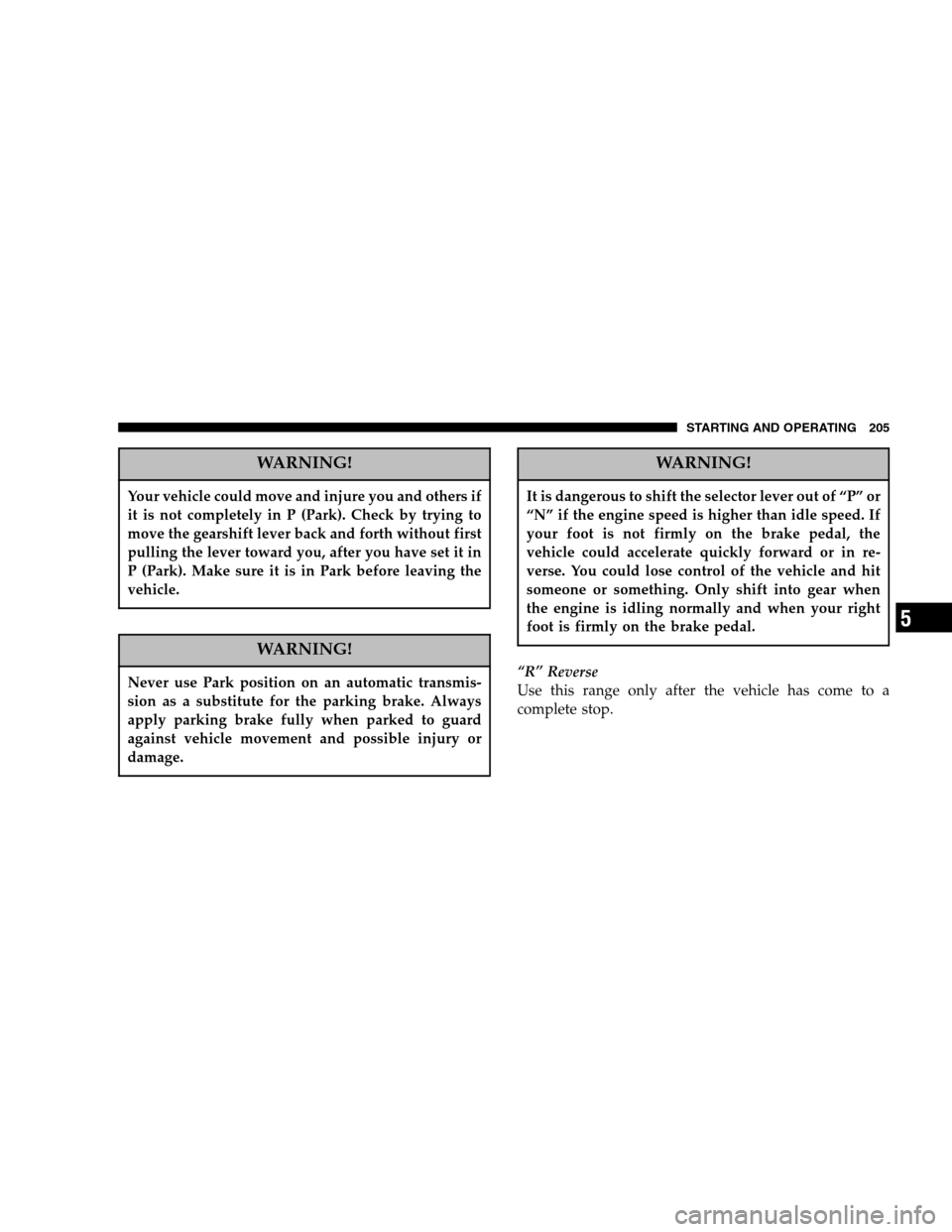Page 200 of 408
▫Recreational Towing 4WD Models .........274
� Traction .............................278 �
Equipment Identification Plate .............279
200 STARTING AND OPERATING
Page 201 of 408

STARTING PROCEDURES
The starter should not be operated for more than 15
second intervals. Waiting a few seconds between such
intervals will protect the starter from overheating.
Manual Transmission
Apply the parking brake, place the gearshift control lever
in NEUTRAL and depress clutch pedal to the floor before
starting the vehicle. This vehicle is equipped with a
clutch interlocking ignition system. It will not start unless
the clutch is depressed.
Automatic Transmission
Start the engine with the shift lever in NEUTRAL or
PARK position. Apply the brake before shifting to any
driving range.
WARNING!
Do not attempt to push or tow your vehicle to get it
started. Vehicles equipped with an automatic trans-
mission cannot be started this way. Unburned fuel
could enter the catalytic converter and once the
engine has started, ignite and damage the converter
and vehicle. If the vehicle has a discharged battery,
booster cables may be used to obtain a start from a
booster battery or the battery in another vehicle. This
type of start can be dangerous if done improperly.
See section 6 of this manual for the proper jump
starting procedures and follow them carefully.
STARTING AND OPERATING 201
5
Page 204 of 408

WARNING!
Remember to disconnect the cord before driving.
Damage to the 110-115 volt electrical cord could
cause electrocution.
AUTOMATIC TRANSMISSION
Automatic Transmission
The electronic PRNDL on the instrument cluster indicates
the transmission gear selected. The selector lever is
mounted on the right side of the steering column. To
drive, move the selector lever from Park or Neutral to the
desired drive position. Pull selector lever toward you
when shifting into Reverse, Second, First or Park, or
when shifting out of Park.
Brake/Transmission Interlock System
This system prevents you from moving the gear shift out
of Park and into any gear unless the brake pedal is
pressed. This system is active only while the ignition
switch is in the ON position. Always depress the brake
pedal first, before moving the gear selector out of PARK.
Gear Ranges
DO NOT race the engine when shifting from Park or
Neutral position into another gear range.
“P” Park
Supplements parking brake by locking the transmission.
Engine can be started in this range. Never use Park while
vehicle is in motion. Apply parking brake when leaving
vehicle in this range. Always apply parking brake first,
then place selector in Park position.
204 STARTING AND OPERATING
Page 205 of 408

WARNING!
Your vehicle could move and injure you and others if
it is not completely in P (Park). Check by trying to
move the gearshift lever back and forth without first
pulling the lever toward you, after you have set it in
P (Park). Make sure it is in Park before leaving the
vehicle.
WARNING!
Never use Park position on an automatic transmis-
sion as a substitute for the parking brake. Always
apply parking brake fully when parked to guard
against vehicle movement and possible injury or
damage.
WARNING!
It is dangerous to shift the selector lever out of “P” or
“N” if the engine speed is higher than idle speed. If
your foot is not firmly on the brake pedal, the
vehicle could accelerate quickly forward or in re-
verse. You could lose control of the vehicle and hit
someone or something. Only shift into gear when
the engine is idling normally and when your right
foot is firmly on the brake pedal.
“R” Reverse
Use this range only after the vehicle has come to a
complete stop.
STARTING AND OPERATING 205
5
Page 206 of 408

“N” Neutral
Shift to Neutral when vehicle is standing for prolonged
periods with engine running. Engine may be started in
this range. Set the parking brake if you must leave the
vehicle.
“D” Drive
For most city and highway driving.
“2” Second
For driving slowly in heavy city traffic or on mountain
roads where more precise speed control is desirable. Use
it also when climbing long grades, and for engine brak-
ing when descending moderately steep grades. To pre-
vent excessive engine speed do not exceed 45 miles per
hour (72 km/h) in this range. “1” First
For driving up very steep hills and for engine braking at
low speeds 25 mph (40 km/h) or less when going down
hill. To prevent excessive engine speed do not exceed 25
mph (40 km/h) in this range.
Overdrive Operation
The overdrive automatic transmission contains an elec-
tronically controlled fourth and fifth (if equipped) speed
(Overdrive). The transmission will automatically shift
from Drive to Overdrive if the following conditions are
present:
•the transmission selector is in Drive;
•the engine coolant has reached normal operating tem-
perature;
•vehicle speed is above approximately 30 mph (48
km/h);
•the “TOW/HAUL” switch has not been activated;
206 STARTING AND OPERATING
Page 207 of 408

•transmission has reached normal operating tempera-
ture.
NOTE: If the vehicle is started in extremely cold tem-
peratures, the transmission may not shift into Overdrive
and will automatically select the most desirable gear for
operation at this temperature. Normal operation will
resume when the transmission fluid temperature has
risen to a suitable level. Refer also to the Note under
torque converter clutch, later in this section.
If the transmission temperature gets extremely hot, the
transmission will automatically select the most desirable
gear for operation at this temperature. If the transmission
temperature becomes hot enough the TRANS TEMP light
may illuminate and the transmission may downshift out
of Overdrive until the transmission cools down. After
cooldown, the transmission will resume normal opera-
tion. The transmission will downshift from Overdrive to Drive
if the accelerator pedal is fully depressed at vehicle
speeds above approximately 35 mph (56 km/h).
When To Use “TOW/HAUL” Mode
When driving in hilly areas, towing a trailer, carrying a
heavy load, etc., and frequent transmission shifting oc-
curs, press the “TOW/HAUL” button. This will improve
STARTING AND OPERATING 207
5
Page 208 of 408

performance and reduce the potential for transmission
overheating or failure due to excessive shifting. When
operating in “TOW/HAUL” mode, 5th gear (if
equipped) is disabled and 2-3 and 3-4 shift patterns are
modified. Shifts into Overdrive (4th gear) are allowed
during steady cruise (for improved fuel economy) and
automatic closed-throttle downshifts to 3rd gear (for
improved braking) will occur during steady braking.
The “TOW/HAUL” light will illuminate in the instru-
ment cluster to indicate when the switch has been
activated. Pressing the switch a second time restores
normal operation. If the “TOW/HAUL” mode is desired,
the button must be pressed each time the engine is
started.
Torque Converter Clutch
A feature designed to improve fuel economy is included
in all automatic transmissions. A clutch within the torque
converter engages automatically at a calibrated speed at light throttle. It engages at higher speeds under heavier
acceleration. This may result in a slightly different feeling
or response during normal operation in high gear. When
the vehicle speed drops below a calibrated speed, or
during acceleration, the clutch automatically and
smoothly disengages. The feature is operational in Over-
drive and in Drive.
NOTE:
The torque converter clutch will not engage
until the transmission fluid and engine coolant are warm
[usually after 1-3 miles (1.6 - 4.8 km) of driving]. Because
the engine speed is higher when the torque converter
clutch is not engaged, it may seem as if the transmission
is not shifting into Overdrive when cold. This is normal.
Pressing the �TOW/HAUL� button, when the transmis-
sion is sufficiently warm, will demonstrate that the
transmission is able to shift into and out of Overdrive.
NOTE: If the vehicle has not been driven in several
days, the first few seconds of operation after shifting the
208 STARTING AND OPERATING
Page 209 of 408

transmission into gear may seem sluggish. This is due to
the fluid partially draining from the torque converter into
the transmission. This condition is normal and will not
cause damage to the transmission. The torque converter
will refill within five seconds of shifting from Park into
any other gear position.
Manual Transmission — 6-Speed
NOTE: The parking brake should be engaged before
leaving the vehicle, especially on an incline.
This model is equipped with a clutch interlocking igni-
tion system. The clutch pedal must be fully depressed to
start the vehicle.
Fully depress the clutch pedal before shifting gears. As
you release the clutch pedal, lightly depress the accelera-
tor pedal. When launching a stationary vehicle, keep the
engine speed low until the clutch is fully engaged. NOTE:
Damage to the clutch can result from starting in
2nd or 3rd gear with a loaded vehicle. Use each gear in
numerical order – do not skip a gear.
When shifting from 5th to 6th gear, do not apply exces-
sive knob load toward the Reverse gear gate, as you may
overpower Reverse crash-through load and unintention-
ally clash into Reverse gear. Also, when shifting from 6th
to 5th gear, excessive knob load toward the Reverse gear
gate will result in blocking of the shift.
To shift into Reverse, come to a complete stop. Depress
the clutch and pause briefly to allow the gear train to
stop. Reverse has a �crash-through�lockout feature. In
order to get into the reverse gate you should start in
neutral 3/4 and move rapidly into the reverse gate in one
swift motion. If you move slowly toward reverse you will
encounter a very high load which makes it difficult to
enter the gate.
STARTING AND OPERATING 209
5